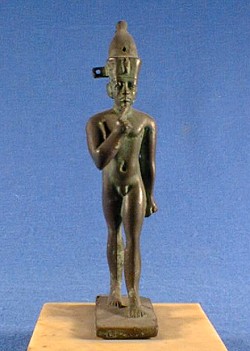
Der griechische Name des Gottes 'Her-pa-chered','Horus das Kind', der in der Spätzeit für alle Formen des Gottes als Kind wie etwa Horus, Sohn der Isis und des Osiris (Harsiese), und der ',junge Horus', die Personifikation der jugendlichen Sonne, stand. Obwohl ein (namentlich) verwandter Gott bereits im Alten Reich erscheint, wurde Harpokrates unter diesem Namen erst vom Neuen Reich an verehrt. Die zahlreichen Bronzestatuetten des Gottes zeigen ihn als Kind mit der Jugendlocke und einem Finger am Mund. In der Griechisch-Römischen Zeit wurden viele Terrakottastatuen von ihm hergestellt, wieder mit den oben genannten Merkmalen und oft auf einem Tier (am beliebtesten waren die dem Gott Amun-Re verbundenen Tiere wie Widder und Gans) oder in einer Sonnenbarke sitzend. Außerdem gibt es Darstellungen eines Kindes auf einer Lotosblüte, was auch mit dem Sonnengott zusammenhängt. Der Gott trägt oft die Kronen Ägyptens. All diese Formen sind auf seine Rolle als Verkörperung der jugendlichen Sonne bezogen. Auch die Anwesenheit des Kindes Horus auf den magischen Stelen besitzt solare Aspekte - er wird mit dem Gott Bes (der alten Sonne) gleichgesetzt; dadurch, daß er als Sieger über gefährliche Tiere dargestellt wird, spielt er auch die Rolle von Harchebis oder Harsiese. Als Bringer der Fruchtbarkeit, was teilweise darauf zurückzuführen ist, daß er ein Sohn des Osiris ist, wird er auch häufig mit einer Getreidegarbe (Assoziation mit Neper) oder mit einem unverhältnismäßig großen Penis (in Verbindung mit Amun-Min) dargestellt. Schließlich spielt der Gott auch die Rolle des Kindes in einer Göttertriade und ist somit mit den Mammisi der Tempel verbunden, wo die Geburt des göttlichen Kindes gefeiert wurde.